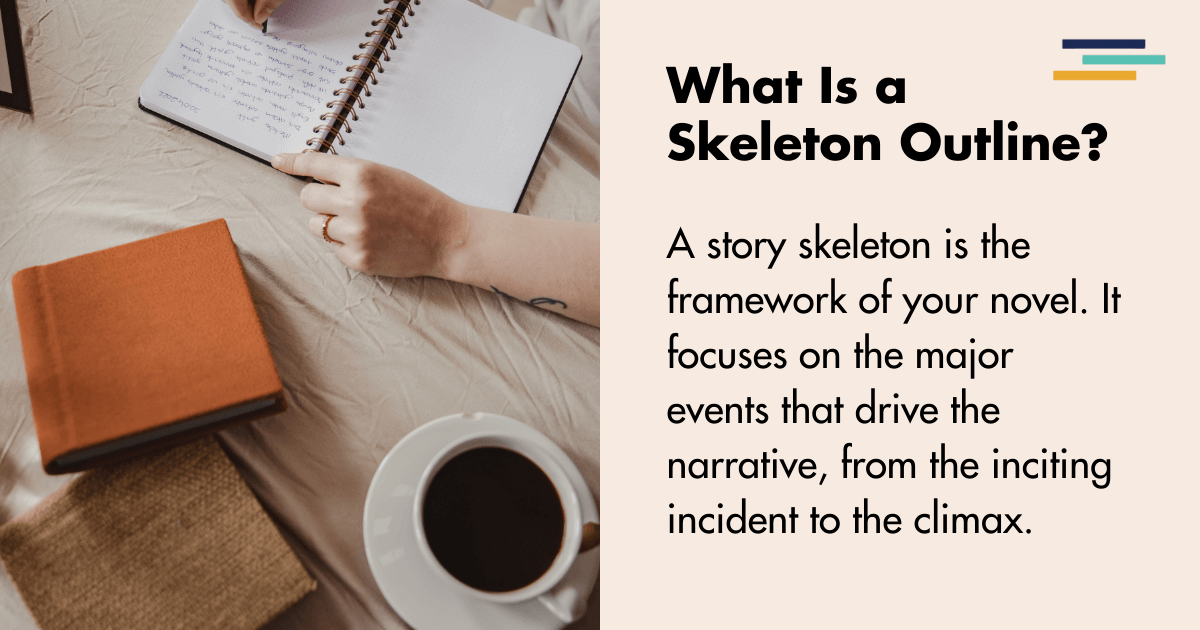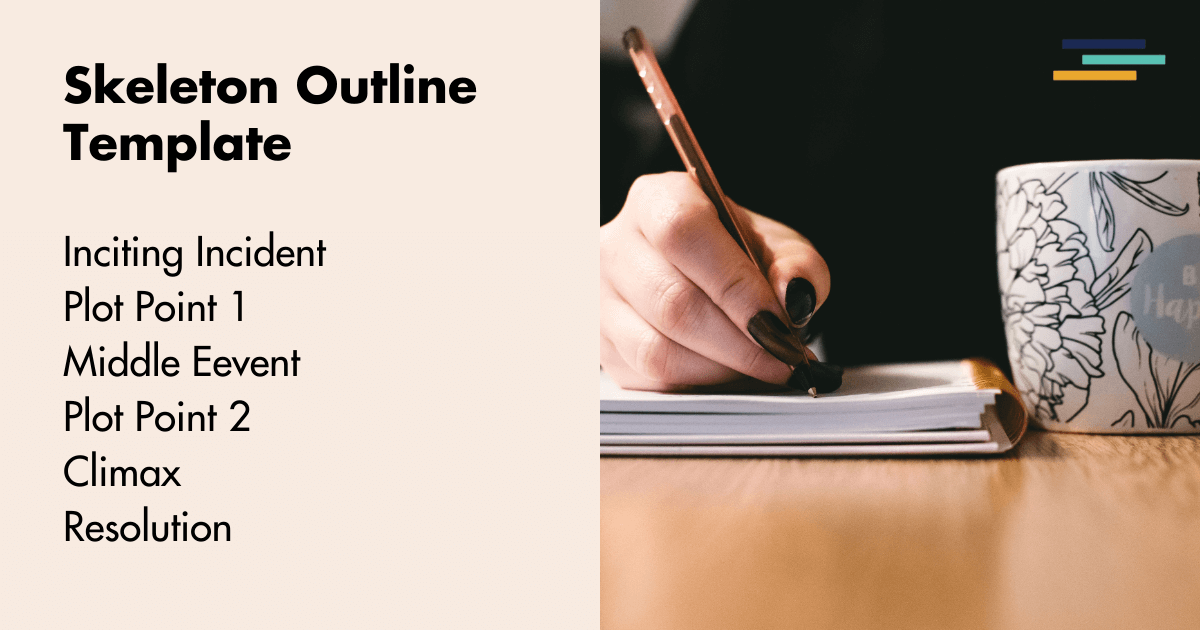
When planning your novel, there’s one word that can either bring a sigh of relief or a shudder of dread…
Outlining.
But fear not, dear writer, because today, we’re talking about one of the most straightforward and effective methods for outlining your story…
The skeleton outline.
Think of it as the bones of your novel, holding everything together, and, thanks to Fictionary’s nifty Skeleton Synopsis feature, you can build your outline without breaking a sweat—or drinking too many cups of coffee.
Take a free trial of Fictionary today and take your story to the next level.
What Is a Story Skeleton?
A story skeleton is the framework of your novel.
It’s the essential plot points that form the backbone of your story.
It focuses on the major events that drive the narrative, from the inciting incident to the climax. By structuring your story around these key moments, you ensure the pacing and flow keep readers engaged and emotionally invested.
Fictionary’s Skeleton Synopsis feature helps you plot your novels by pinpointing these essential moments.
Here’s a quick rundown of the key plot points in the Skeleton Synopsis, and how Fictionary approaches them.

Inciting Incident
The inciting incident is when the protagonist’s life changes dramatically, propelling them into action.
It’s not just a minor inconvenience…
It’s a game-changer that sets the story in motion.
Fictionary recommends making sure this happens within the first 15% of your novel, or you risk losing the reader’s interest. This moment shouldn’t be backstory or a summary. Let the reader experience it firsthand alongside the protagonist to build an emotional connection.
Plot Point One
Plot Point One occurs at around the 25% mark and is the point of no return for your protagonist.
At this stage, the character must make a decision that pulls them deeper into the central conflict. According to Fictionary, this moment marks the end of Act I. It’s the moment where the character can’t back out and they fully commit to the journey ahead.
Middle Event
The middle of your novel—around the 50% mark—should be where your protagonist transitions from reactive to proactive.
Something dramatic happens that forces them to take charge and move the story forward.
This moment, often called the “midpoint,” marks a shift in the character’s role within the story.
Plot Point Two
Plot Point Two, at around the 75% mark, is the lowest point for your protagonist.
This is when everything falls apart.
Plans fail, hopes get crushed, and the character feels like all is lost. But this “dark night of the soul” moment is also the turning point, as it propels the character toward the climax.
Climax
The climax is the moment of the highest tension and conflict in your story, around 90% of the way through.
The protagonist faces their biggest challenge and must determine their fate. Fictionary emphasizes your protagonist must be involved in this scene for it to pack an emotional punch.
Resolution
The resolution is where all the loose ends of your story get tied up and the character’s journey comes to a close.
It follows the climax and gets sometimes referred to as the “denouement.”
The resolution answers the remaining questions, wraps up the story arcs, and shows how the protagonist’s life has changed after overcoming their central conflict.
Fictionary emphasizes the importance of ensuring the emotional impact on the protagonist is clear by the end of the resolution. After all, you’ve invested the reader in this character’s journey.
Now it’s time to show how that journey has shaped them.
In many stories, the resolution is where we see the protagonist either enjoying the fruits of their labor or reflecting on their losses and growth. The key is to make sure it feels satisfying, whether it’s a happy ending, bittersweet, or tragic.
Want more information?
Read this article on How to Write a Synopsis: https://temp-fictionary.flywheelstaging.com/journal/how-to-write-a-synopsis/
Benefits of a Simple Skeleton Outline
Why should you use a skeleton outline? Well, for starters, it’s like a roadmap that prevents you from getting lost in your own story.
Here are a few more benefits to consider.
1. Clarity Without Constraints
A skeleton outline gives you clarity without bogging you down with unnecessary details. You can see where your story is headed without feeling locked into a rigid plan.
2. Flexible Yet Structured
You’ll have enough structure to avoid plot holes but enough flexibility to let your creativity flow. If a character suddenly makes a bold move (as they often do), you can adjust your skeleton outline without tearing it apart.
3. Saves Time in the Long Run
By identifying your main plot points early on, you’ll save time when writing and revising. Trust me, you’d rather discover a missing plot twist in the outline stage than after you’ve written 70,000 words.
4. Helps Avoid Writer’s Block
With a clear sense of direction, you’re less likely to hit the dreaded writer’s block. You’ll always know where your story is headed, which keeps you motivated and focused.
5. Supports a Stronger Story Arc
A skeleton outline ensures that your story’s arc is solid from the start. Each major plot point gets planned out, so your narrative has momentum and direction. No saggy middles here, folks.
Skeleton Outline Examples
Here’s where the fun begins.
Let’s look at how some of your favorite books would look with a skeleton outline. These examples show how a few key scenes can drive an entire story forward.
Harry Potter and the Sorcerer’s Stone by J. K. Rowling
- Inciting Incident: Harry receives his letter from Hogwarts. This moment is the catalyst that changes Harry’s life forever. He’s invited to the wizarding world and learns of his true identity, forcing him to confront a new reality.
- Plot Point 1: Harry boards the Hogwarts Express and begins his journey into this new world. He’s crossed the threshold and there’s no turning back. His life at Hogwarts brims with magic, danger, and mystery.
- Middle Event: Harry discovers the link between the Sorcerer’s Stone and Voldemort’s return. This is a major revelation that drives the story forward. Harry now understands the gravity of the situation and takes more proactive steps to confront the threat.
- Plot Point 2: Harry, Ron, and Hermione decide to go after the Sorcerer’s Stone themselves. This marks Harry’s lowest point of doubt. If they fail, Voldemort will return, but they know they must act.
- Climax: Harry confronts Quirrell/Voldemort and prevents the Sorcerer’s Stone from falling into Voldemort’s hands. The fate of both Harry and the wizarding world hangs in the balance, and this is the moment where Harry proves himself.
- Resolution: The school year ends, and Harry returns to the Dursleys, forever changed by the events at Hogwarts. Though the immediate danger has passed, Harry now understands the larger, darker forces at play in the wizarding world.

The Hunger Games by Suzanne Collins
- Inciting Incident: Katniss volunteers as a tribute in place of her sister, Prim. This is the dramatic moment that thrusts her into the Games, altering her life forever and setting the story into motion.
- Plot Point 1: Katniss gets thrust into the Capitol’s bizarre and deadly world, where she must prepare for the Games. She realizes there is no going back. Her focus must be on survival.
- Middle Event: Katniss forms alliances and strategizes as she confronts the brutality of the Games. The midpoint shifts Katniss from being a reactionary character to someone who is actively making decisions about her survival.
- Plot Point 2: After Rue’s death (lowest moment), with only a few remaining competitors, Katniss and Peeta must decide whether to fight or work together to survive. The odds are stacked against them, and they face the grim possibility of death, but Katniss pushes through with a new plan.
- Climax: Katniss outsmarts the Gamemakers by threatening to eat poisonous berries with Peeta, forcing them to declare them both winners. The tension reaches its peak as Katniss risks everything to win on her terms.
- Resolution: Katniss and Peeta return home, but they’ve sown the seeds of rebellion, and Katniss knows life will never be the same. Her victory comes with unintended consequences, setting the stage for future conflicts.
The Da Vinci Code by Dan Brown
- Inciting Incident: Robert Langdon is called to the Louvre after a murder takes place, and he’s asked to help solve the mystery. This event sets the entire plot into motion, pulling Langdon into a world of secret societies and religious mysteries.
- Plot Point 1: Langdon discovers that the victim, Saunière, has left a series of cryptic clues. This moment propels Langdon deeper into the mystery, with no choice but to solve the puzzle before it’s too late.
- Middle Event: Langdon and Sophie discover the existence of a secret society connected to the Holy Grail. The stakes get raised, and the mystery takes on a deeper significance as they must now unravel a centuries-old secret.
- Plot Point 2: An ally betrays Langdon and Sophie, forcing them to reevaluate who they can trust. The betrayal marks a low point for the protagonists, where their mission appears to be doomed.
- Climax: Langdon confronts the antagonist and finally pieces together the mystery of the Grail. The story’s biggest revelations come to light, with Langdon using everything he’s learned to confront the truth.
- Resolution: Langdon deciphers the last clue and finds peace with the discovery, knowing the world’s most powerful secret is safe for now. The resolution ties up the loose ends and brings closure to the mystery, but also leaves room for future adventures.
Skeleton Outline Template
Now, here’s the part you’ve been waiting for…
Your very own skeleton outline template.
Whether you’re using Fictionary’s Skeleton Synopsis feature or doing it the old-fashioned way (pen and paper or fingers to keyboard), this template will help you map out the key points of your story.
Inciting Incident
What kicks off the action?
[POV Character] must [POV Goal]. [Scene Middle]. [Scene Climax]. [Impact on POV].
Plot Point 1
What is the point of no return?
[POV Character] must [POV Goal]. [Scene Middle]. [Scene Climax]. [Impact on POV].
Middle
How does your protagonist shift from reactive to proactive?
[POV Character] must [POV Goal]. [Scene Middle]. [Scene Climax]. [Impact on POV].
Plot Point 2
What is your protagonist’s lowest moment?
[POV Character] must [POV Goal]. [Scene Middle]. [Scene Climax]. [Impact on POV].
Climax
What is your protagonist’s big showdown where you decide their fate.
[POV Character] must [POV Goal]. [Scene Middle]. [Scene Climax]. [Impact on POV].
Resolution
How will you tie up the loose ends and bring your story to a satisfying conclusion.
[POV Character] must [POV Goal]. [Scene Middle]. [Scene Climax]. [Impact on POV].
Skeleton Outline Writing Tips
Before you run off to start your next novel, here are a few tips to make sure your skeleton outline is as strong as possible.
1. Start with the Big Moments
Focus on your story’s five key turning points:
- The Inciting Incident
- Plot Point One
- The Middle Event
- Plot Point Two
- The Climax
These are the spine of your novel, so make sure they’re solid.
2. Leave Room for Growth
Your skeleton outline is a guide, not a contract. If your characters surprise you or a plot twist emerges organically, let your outline develop.
3. Use Fictionary’s Skeleton Synopsis Feature
The Skeleton Synopsis in Fictionary helps you map out your novel’s key moments. It takes the guesswork out of structuring your plot and ensures that your scenes build toward a satisfying climax.
4. Don’t Overthink It
This is a rough outline, not a polished draft. Keep it simple and focus on moving the story forward. You can always go back and add details later.
5. Visualize Your Story Arc
If you’re a visual learner, Fictionary’s Story Arc tool will help you see how your plot is shaping up. This feature allows you to spot gaps, uneven pacing, or missed opportunities for tension.
And finally, always remember that the story comes first. Focus on:
- Creating engaging characters
- Penning interesting plots
- Structuring solid settings
A tool like Fictionary helps you turn your draft into an interesting story readers love. So, with a strong narrative foundation, your writing can truly shine.


